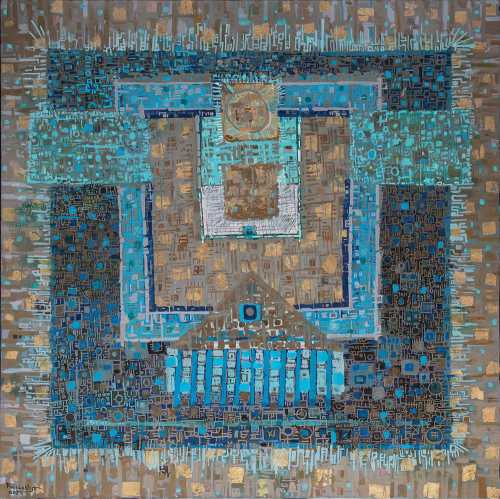About Jafar Rouhbakhsh
Jafar Rouhbakhsh is a painter who built a bridge between Iranian art and modern art, therefore he could be considered as one of the painters of the Sagha Khaneh movement. Jafar Rouhbakhsh studied at the Boys School of Fine Arts from 1957 to 1960. In 1963, he entered the Faculty of Decorative Arts in Tehran and graduated with a bachelor's and master's degree in decorative painting and interior design architecture. A number of his works were showcased in 1959 in the group exhibition of Reza Abbasi Hall and also in Farhang Hall in Tehran. He held his first solo exhibition in 1965 at the Faculty of Fine Arts in Tehran. After that, his works were displayed in numerous group and solo exhibitions.
In the early 1970s, he went to France to study and research in the field of decorative arts. He spent some time at one of the French art centers in sculpting, hand-printing, and Engraving. After the Islamic Revolution, he returned to Iran and lectured in the primal principles of design and printing techniques.
Rouhbakhsh generated a bridge between the Iranian painting's legacy and modern art by using rug patterns, old handicrafts, and folk figures in an abstract context. His works could be divided into three main periods: the 1960s strongly influenced by Oriental arts, in the 1970s influenced by his trip to Europe, Western motifs appear in his works. the third period, which began with a return to Orientalism, and had continuity to His last works, so that in the last ten years of his career, he created artworks with a theme of flowers and chickens, with decorative figures and bright colors like jewelry. His art is a median between two different essences in Iranian painting, a bridge between Sagha Khaneh and abstraction.
Rouhbakhsh says about the inspiration of traditional art nowadays: "there is no specific measures or regulations in how much should be influenced by traditionalism or how much should be enclosed in new horizons and explored" I believe that the artist's masterstroke is a proportionate perception of these two, and the measure of his success also depends on these two factors."
In the early 1970s, he went to France to study and research in the field of decorative arts. He spent some time at one of the French art centers in sculpting, hand-printing, and Engraving. After the Islamic Revolution, he returned to Iran and lectured in the primal principles of design and printing techniques.
Rouhbakhsh generated a bridge between the Iranian painting's legacy and modern art by using rug patterns, old handicrafts, and folk figures in an abstract context. His works could be divided into three main periods: the 1960s strongly influenced by Oriental arts, in the 1970s influenced by his trip to Europe, Western motifs appear in his works. the third period, which began with a return to Orientalism, and had continuity to His last works, so that in the last ten years of his career, he created artworks with a theme of flowers and chickens, with decorative figures and bright colors like jewelry. His art is a median between two different essences in Iranian painting, a bridge between Sagha Khaneh and abstraction.
Rouhbakhsh says about the inspiration of traditional art nowadays: "there is no specific measures or regulations in how much should be influenced by traditionalism or how much should be enclosed in new horizons and explored" I believe that the artist's masterstroke is a proportionate perception of these two, and the measure of his success also depends on these two factors."
The Most Expensive Artwork
At Auctions
First Attendance
31 October 2007
# Attendance
88
# Artworks
101
Average Realized Price
22,429 USD
Average Min Estimate
14,778 USD
Average Max Estimate
21,021 USD
Sell-through Rate
65.657%
Average Growth of Artwork Worth
26.792%
Timeline
American, European and Ukrainian Fine Art auction
22 August
A177: Swiss and International Art, Design auction
18 June
The 22nd Tehran - Modern, Classic and Traditional Iranian Art auction
14 February
Modern And Contemporary Art of The Middle East auction
30 January
American, European and Ukrainian Fine Art auction
15 December
Post-war & Contemporary Art auction
6 December
The 21st Tehran - Contemporary Iranian Art auction
11 October
Classic, 20th and Contemporary auction
18 September
American, European and Ukrainian Fine Art auction
16 August
Middle-East/20th Century Art auction
11 July
American, European and Ukrainian Fine Art auction
28 June
Modern & Contemporary Art auction
25 June
Summer Sale auction
20 June
10s of Artworks, 10s of Millions exhibition
8 March
The Artwork of Legendary Artists exhibition
9 February
The 19th Tehran -Classic and Modern Iranian Art auction
24 January
Gozar Project exhibition
19 January
Modern Collectore exhibition
19 January
American, European and Ukrainian Fine Art auction
8 December
American, European and Ukrainian Fine Art auction
6 October
The 17th Tehran Modern and Contemporary Iranian Art auction
18 July
International Art auction
4 November
Art Closer Than Ever exhibition
26 August
Fine Arts auction
12 August
MIDDLE EAST MODERN & CONTEMPORARY auction
5 July
Geometric Abstraction in Contemporary View exhibition
10 June
Group Exhibition Nasut and Nature 2 exhibition
13 May
The last event 1400 exhibition
25 February
Point Of View exhibition
25 February
Arte Moderna e Contemporanea auction
17 February
Middle Eastern Art Online Sale auction
9 February
The 15th Tehran- Modern Iranian Art auction
14 January
Modern and Contemporary Art - Design auction
18 December
Modern and Contemporary Middle Eastern Art including Baghdadiyat Part II auction
17 November
MODERN AND CONTEMPORARY ART auction
23 October
Modern and Contemporary Art auction
22 September
American, Russian & European Fine Art auction
12 August
International Art auction
7 May
Souvenir exhibition
2 February
The 13th Tehran- Modern and Contemporary Iranian Art auction
15 January
Dobiaschofsky - Nov 2020 auction
6 November
No.6 auction
16 October
Collector 6 exhibition
18 September
One by One exhibition
3 July
Schuler Auktionen Zurich - June 2020 auction
22 June
XXth and contemporary art auction
18 June
Schuler Auktionen Zurich - March 2020 auction
23 March
Rusterholtz Feb 2020 auction
1 February
5th Collector exhibition
24 January
Christmas auction
15 December
Cornette De Saint Cyr auction
15 December
POST-WAR & CONTEMPORARY ART auction
13 December
Dobiaschofsky Bern Nov 2019 auction
8 November
Middle Eastern, Modern and Contemporary Art auction
23 October
یازدهمین دوره حراج تهران auction
5 July
Modern and Contemporary Middle Eastern Art auction
1 May
Rusterholtz Auktionen - Feb 2019 auction
2 February
2018 Collection Selling exhibition
17 January
دهمین دوره حراج تهران auction
11 January
Art contemporain & design auction
18 December
Dobiaschofsky Auktionen - Nov 2018 auction
9 November
Modern and Contemporary Middle Eastern Art auction
24 October
The 9th Tehran- Classic and Modern Iranian Art auction
29 June
Drouot Richelieu, Salle 5, Post War & Art Contemporain auction
18 June
Dubai: Post War and Contemporary Art auction
22 March
Vente aux encheres auction
6 March
Rusterholtz Galerie and Auktionen - Jan 2018 auction
27 January
Dobiaschofsky Auktionen 10 Nov 2017 auction
10 November
Paintings auction
27 September
هفتمین دوره حراج تهران auction
7 July
20th Century Art/ Middle East auction
25 April
VERBIER auction
31 July
Auctionata Jne 2016 auction
30 June
Paintings auction
4 June
پنجمین دوره حراج تهران auction
27 May
Drouot Richelieu, Salle 10, Post War & Art Contemporain* auction
30 March
Dubai: Modern and Contemporary Art Now and Then auction
16 March
Swiss and International Art , Art Deco, Design , Abstract Art and Contemporary at Galartis SA auction
5 December
Art Abstrait et Contemporain auction
4 December
VERBIER auction
2 August
چهارمین دوره حراج تهران auction
29 May
ABSTRACT & CONTEMPORARY ART - FOREIGN PAINTERS OF THE PARISIAN SCENE auction
10 December
Vintage, Art Nouveau, Art Deco, Design, Works of art of the XXth, Abstract and Contemporain Art, Collectible Vehicles at Galartis SA auction
15 June
سومین دوره حراج تهران auction
30 May
Drouot Richelieu, Salle 1, Art Contemporain auction
28 March
Modern & Contemporary Arab, Iranian & Turkish Art auction
19 March
Painting Exhibition Jafar Rouhbakhsh exhibition
21 February
دومین دوره حراج تهران auction
28 May
Drouot Richelieu, Salles 1 & 7, Art Contemporain auction
14 November
1Ere Vente a Dubai International Modern And Contemporary Art auction
22 October
اولین دوره حراج تهران auction
22 May
Drouot Richelieu, Salles 1 & 7, Art Contemporain auction
4 April
Contemporary Art / Arab & Iranian auction
4 October
Koller Geneve - May 2011 auction
27 May
Tableaux Orientalistes et Art Moderne Arabe et Iranien auction
9 November
International Modern and Contemporary Art auction
26 October
International Modern & Contemporary Art auction
27 October
International Modern & Contemporary Art auction
29 April
International Modern and Contemporary Art auction
30 April
International Modern & Contemporary Art auction
31 October
Articles
۱7th Tehran Auction Sales Report 26 July 2023
The 17th Tehran auction: modern and contemporary, was held on Friday July 21st, 2023 at Parsian Azadi Hotel. This auction achieved a total sale of 214 billion tomans equivalent to 4.3 million dollars, which was a growth of 77.8% compared to the previous period. Artchart has observed the 17th Tehran auction in the upcoming report.

